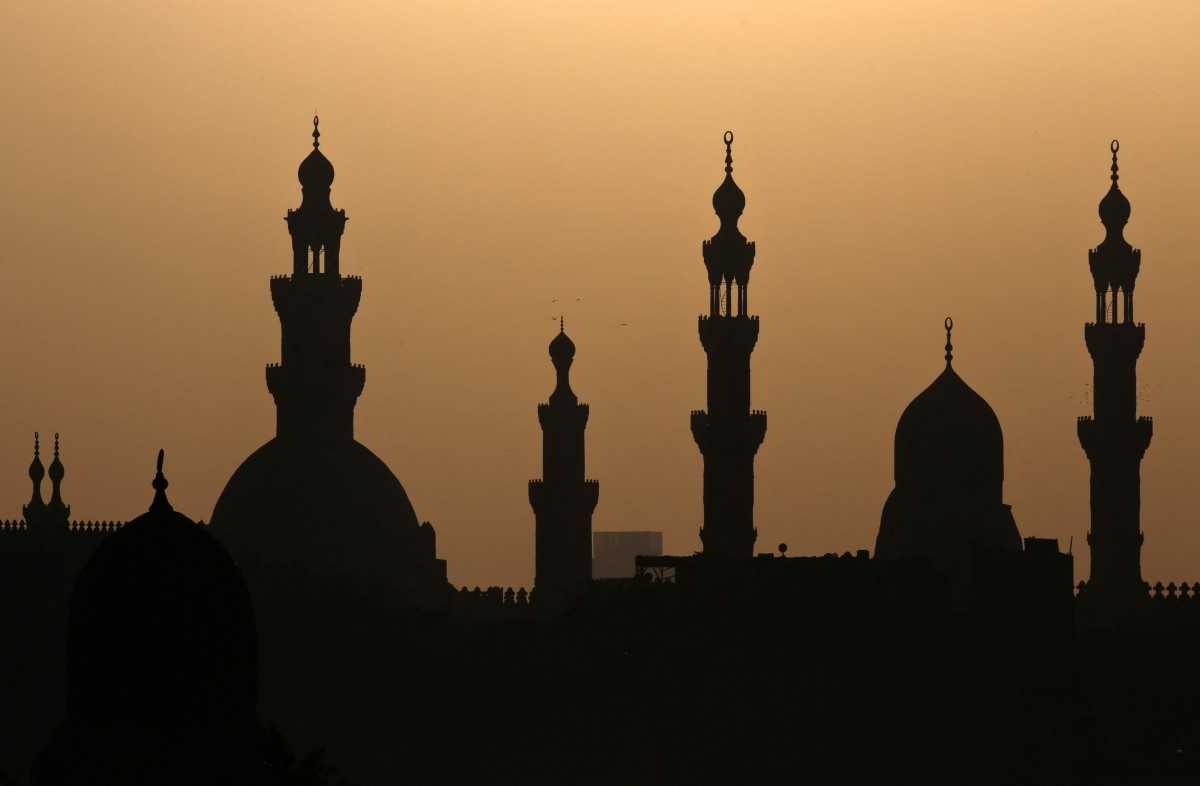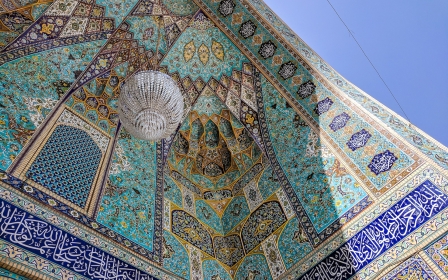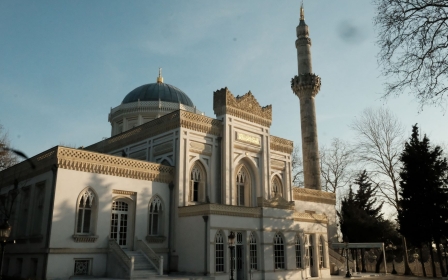The art of the adhan: The multiple melodies of the Muslim call to prayer

Since the early days of Islam, the adhan has been chanted to call Muslim worshippers to each of the five daily prayers. It is timed meticulously, in accordance with the sun’s position in the sky from first light until nightfall, beginning with the dawn prayer – or fajr – and ending with the evening prayer, isha.
Literally meaning "to inform" or "to announce", the adhan is usually broadcast from the minarets of mosques across the Muslim world for congregational prayers, but is also recited by individual worshippers performing the obligatory prayers wherever they happen to be. In Muslim communities, the adhan is gently recited in the right ear of a newborn baby, as a welcome to the world.
The beauty of the call lies in its melody, which can have the power to captivate the ears of Muslims and non-Muslims alike.
Traditionally, the muezzin – the person who recited the adhan – would be chosen from among the community solely for his strong and beautiful voice, says Imam Hafiz Ali Tos from the Cambridge Central Mosque in England.
New MEE newsletter: Jerusalem Dispatch
Sign up to get the latest insights and analysis on Israel-Palestine, alongside Turkey Unpacked and other MEE newsletters
“The muezzin […] would climb to the top of the tower to call the faithful to the mosques for collective or jamaa prayer,” he adds.
Imam Ali says he gave his first adhan when he was just five years old, to a room full of family elders in his home city of Konya, in south-central Turkey. Growing up surrounded by the many minarets of mosques built under the Seljuk Turks, Imam Ali couldn’t help but be inspired by the “enchanting” sound of the call.
“My family complimented my voice and encouraged me to say the adhan, and I’d get a gift for saying it clearly. Myself and other local boys would then compete to see who could recite it the best.”
Although a euphonious voice is a must, historically muezzins needed additional qualifications – to be well versed in tajweed, the rules of pronunciation, and be punctual time-keepers able to accurately determine the time of day, says Shaykh Ahmed Saad, director of the Ihsan Institute, a UK-based centre for studying Islam. They would also need to be fit enough to climb (and descend) a long spiral staircase to the top of a minaret five times a day.
“It would be easier to train for the army,” he jokes.
The early years
The standard words that make up the adhan came a few years after the arrival of Islam.
Early Muslims in 7th-century Arabia were small in number and would let one another know it was time to pray by word of mouth. But as their numbers grew, Prophet Muhammad and his companions would often discuss the best way to gather the community for prayer.
A horn, similar to the Jewish shofar, was considered, as were bells like those used by Christians to call people to church service.
One hadith (reported sayings and traditions of the prophet) states that a companion of the prophet, Abdullah Ibn Zayd, had a dream telling him to use the human voice to make the call to prayer, and that he was also told the words to be recited.
Bilal ibn Rabah al-Habashi, a freed Abyssinian slave and early convert to Islam, was chosen to give the call to prayer because of his beautiful voice. The same words from that 7th-century dream are still recited today, with some phrases repeated:
God is Great, God is Great (Allahu Akbar, Allahu Akbar)
I bear witness that there is no god except the One God
I bear witness that Muhammad is the messenger of God
Hurry to the prayer, Hurry to success
God is great, God is great
There is no god except the One God
Changes to the prayer call
The adhan is recited in Arabic and can be heard across skylines in parts of Nigeria, Malaysia and even Europe. The East London Mosque in the UK, and several mosques in the Netherlands, play the adhan publicly several times a day.
In 1923, following the collapse of the Ottoman Empire and under the presidency of Mustafa Kemal Ataturk, the adhan was given in Turkish as the country went through a period of nationalism. It wasn’t until 1950, when Adnan Menderes came to power, that the traditional Arabic adhan was reintroduced to Turkey. It has remained in place since.
Sunni and Shia Muslims also have slight variations, with the latter including the words: "I bear witness that Ali is the friend of Allah" in reference to Ali ibn Ali Talib, the prophet's cousin and later a venerated figure.
There was also a temporary change to the words recited in the adhan following the emergence of the Covid-19 pandemic in 2020. In Kuwait, the words "come to prayer" were replaced with "pray in your homes" in the call, to deter people from praying communally at mosques.
'Each [Egyptian] governorate used to hold auditions and applicants would have to go through tests and exams'
- Shaykh Ahmed Saad, director of the Ihsan Institute
Though typically melodious, in some densely populated Muslim-majority cities the simultaneous announcements can become discordant.
The Egyptian government began implementing the Tawheed Al Adhan, or Adhan Unification Project, in 2010 to remove the multitude of adhans heard in Cairo - where there are an estimated 4,000 official mosques and 30,000 “unofficial mosques” - and play out one standardised adhan over state radio.
This was the start of the decline of the muezineen (plural for muezzin) in Egypt, says Shaykh Saad of his native country: “Each governorate used to hold auditions and applicants would have to go through tests and exams to make sure they were suitable for the job,” he said.
He adds that, with the unification project, this no longer happens; instead, each of Egypt’s 29 governorates has one muezzin appointed who makes the call from a mosque, and this adhan is then broadcast live across the local area.
This “erosion of tradition” saddens Shaykh Saad: “I feel like the creativity of the adhan melodies is being lost… the landscape of the adhan now feels barren.”
One place where giving the call to prayer is still an art is the ancient city of Damascus.
In the eighth-century Great Umayyad mosque in Damascus, six muezzins collectively recite the adhan in front of a loudspeaker that plays out across the ancient city from three of the mosque's minarets.
This group recitation of the adhan is known as Al-Jawq, and it’s unique to Syria, originating 500 years ago as a way to inform pilgrims destined for Mecca that it was time for prayer. The six are part of a select group of 25 muezzins who take turns to recite collectively in a style particular to the mosque.
The art of the adhan
Although the words remain consistent, careful listeners to the call will be able to pick up subtle differences in the rhythm and tone of the words.
“The art of the adhan was developed during the Ottoman Empire, and was a creative way for listeners to be able to tell the time of prayer just by hearing the tone of the adhan,” said Shaykh Saad.
“Remember, there were no watches back then, and someone may be busy at work, on their farm, or blind and unable to see the time of day, but just by hearing the tone of the adhan they would know which prayer it was.”
Based on variations of the Middle Eastern maqam melodic system, incorporating scales, phrases and harmonies to create a “mood” in both classical music as well as Quran recitation, the prayer call can evoke myriad emotions. For example, an adhan recited in the Nahawand maqam – named after the Nahavand province in Iran, where it originated – is melancholic and often used for the mid-afternoon asr prayer on a Thursday, Imam Ali says, to mark the onset of Friday, a holy day in Islam.
Shaykh Saad says that maqam Bayati is the classic adhan style. Described as a “relaxing adhan with warm, deep tones”, it is often used for the midday prayer, or dhuhr.
“Dhuhr is the mother of prayers and Bayati the mother of maqams,” says Saad. “The midday prayer was the first to be established by early Muslims.”
Although there has been no standardisation as to which maqam should be used for which prayer adhan, it became “ritualistic and people organised among themselves over time, with certain ones more commonly used for certain prayers, but they are not necessarily always used”, explains Shaykh Saad.
Maqam Sabah’s slow and steady rhythm is commonly heard at dawn, for the fajr prayer to gently lull worshippers into the mosque, but the quick beat of maqam Segah is often associated with the sunset prayer, or maghrib, when time can be limited.
"Maghrib time is also the time Muslims break their fast (during Ramadan and additional fasts outside of the holy month). They will not want a long adhan at this time," Imam Ali says. "Also, in the month of Ramadan after the fast is broken, people have to get ready for the additional evening prayers of tarawih. So this adhan and prayer are kept short."
In Tunisia, trainee muezzins go to the Rachidi Institute of Tunisian Music to fine-tune their maqam style and adhan performance.
“It can take between six months to more than a year for a muezzin to be fully trained, it all depends on how quickly they can pick up the subtleties in style, how good their ears are, and their aptitude,” says Shaykh Saad.
A student learning how to recite the Quran may choose a particular maqam to recite in, and with time and expertise will likely develop their own style, and dip in and out of different maqams to reflect the mood of the passage being recited.
“If you are reading a passage about day and night, heaven and hell, you would use [maqam] Segah, as it goes up and down… like a wave, it contrasts emotions,” says Shaykh Saad.
The steady rhythm of the Egyptian Sheikh Mohammad Rifat’s maghrib adhan still has the power to move Shaykh Saad.
As a child in the 1990s, he listened to the late sheikh at his parents’ home in the governorate of Monufia, in northern Egypt; and it’s this same adhan that is still played every year on the country’s national radio at maghrib time in Ramadan.
“[Sheikh Mohammad Rifat] epitomises the holy month, he is Ramadan and Ramadan is him, the two are eternally bound,” says Shaykh Saad.
Born in 1882, and popular for his melodious voice, Sheikh Rifat was the first person to recite the Quran in Arabic on BBC Radio, in 1935. He died in 1950, yet his “legacy lives on”, says Shaykh Saad.
“No wonder he was known as the Voice of Heaven – all these years later it still feels like his adhan is coming to us from somewhere heavenly.”
This article is available in French on Middle East Eye French edition.
Middle East Eye delivers independent and unrivalled coverage and analysis of the Middle East, North Africa and beyond. To learn more about republishing this content and the associated fees, please fill out this form. More about MEE can be found here.









